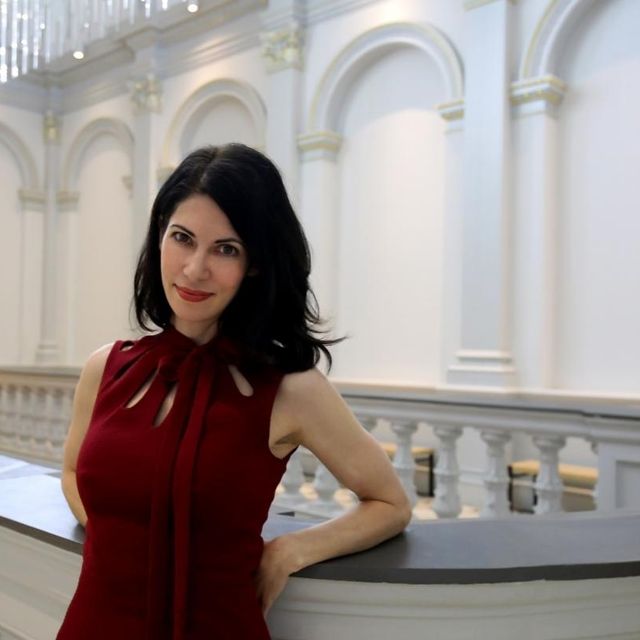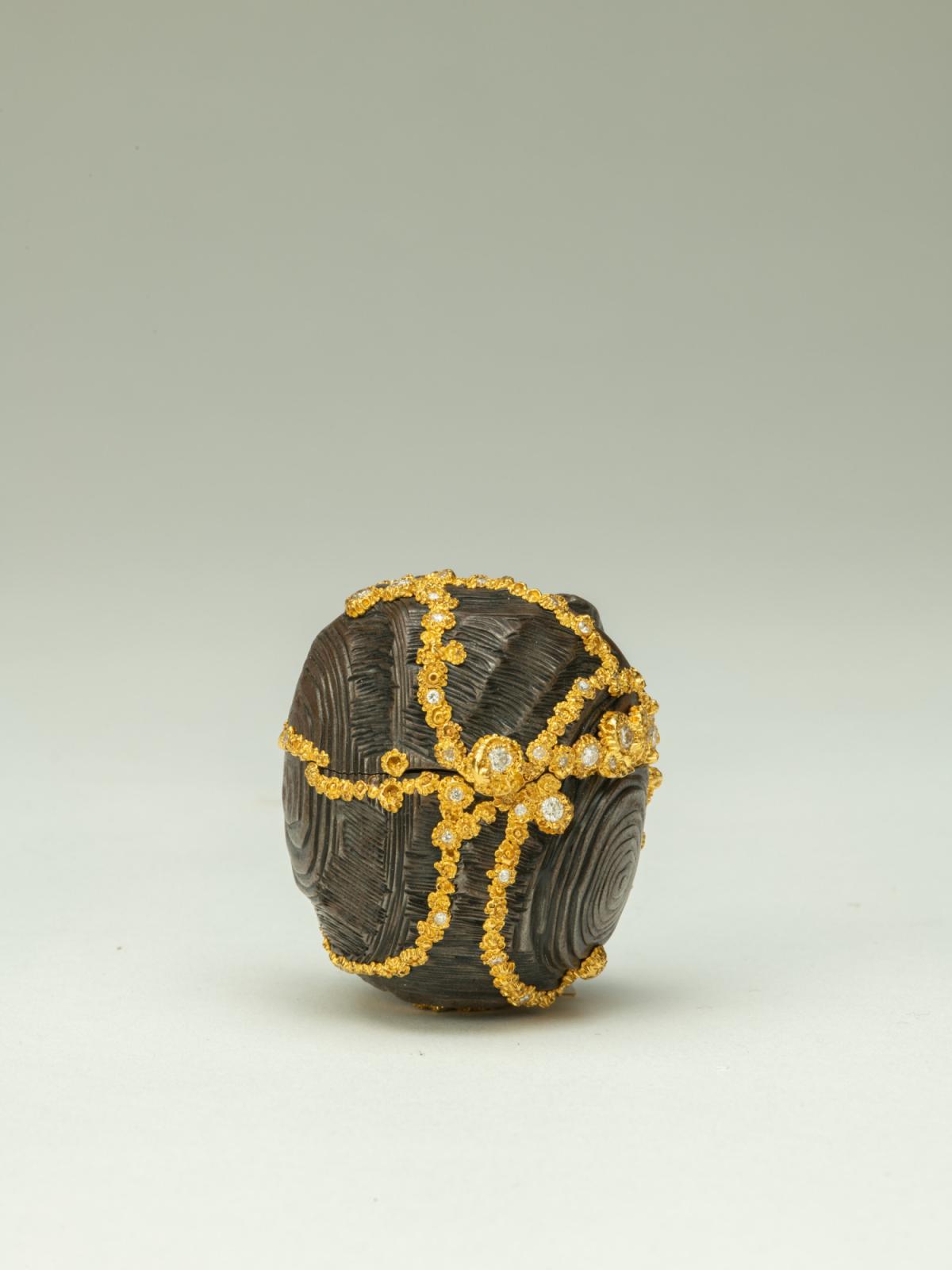
On November 26, 2022, the world lost one of the great poets of craft, Daniel Brush. While I never had an opportunity to meet Mr. Brush, it would have been one of the truly great honors. Those he met, he seems to have entranced, and though he was not widely known, those who knew, knew. No one could speak of Brush or his work without waxing poetic. While it may have been hyperbole to compare Brush to Picasso or Van Gogh, as Christie’s auction house once did, he was undoubtedly a reclusive genius, one of the more enigmatic figures in the field of metalsmithing—a true master of his craft.
I was familiar with Brush’s work from catalogues and had heard fabled stories about the man, but until recently, I had never encountered one of his pieces in the flesh. That magical experience occurred on a visit with craft collector Fleur Bresler, who later offered the museum its only three-dimensional piece in the collection by Brush—a magnificent diamond encrusted egg. It was at the end of a memorable afternoon, perusing Mrs. Bresler’s collection, that she offered me this last surprise. She asked me to close my eyes and put out my hands, and handed me this exquisite object, which landed heavy and cool. I wish I could truly describe the sensation: it’s made of steel, diamonds, pure gold, and wonder. Although it’s less than two inches in diameter, its heft is significant. It glitters as it catches the light, emanating a peculiar intimacy. Brush himself spoke of the importance he placed on passing his work “from warm hands to warm hands.” In my hands, I could feel that history.
Daniel Brush was an interesting character, to say the least. Over his lifetime, he cultivated a kind of legendary status, both for his unparalleled skill and his eccentricity. Though Brush made art for more than five decades, he never had a dealer. Those lucky few who know of him and count themselves collectors— including the Metropolitan Museum of Art, the Victoria and Albert Museum, even royalty — might more appropriately be called caretakers. In selling work, he always insisted on knowing his clients, and turned many down. He has been called a poet, a goldsmith, even a “magician” by Nicolas Bos, CEO of Van Cleef and Arpels. Yet, while he is far better known for his objet d’art, he still preferred the moniker of painter.
Born in Cleveland in 1947, Brush received a bachelor of arts from the Carnegie Institute of Technology and a master's degree in fine arts from the University of Southern California. He then moved to Washington, DC in the 1970s to take a tenured position in the department of art at Georgetown University. While in Washington, he earned cache for his large-scale paintings and drawings, inspired by Noh theater and abstract art.
But fame didn’t sit well with Brush. In 1978, following a well-received solo show at the Phillips Collection, he suddenly renounced his tenure and retreated from the social scene. He left Washington bound for New York, where he and his wife bought a studio in an old garment factory in Manhattan. There he worked reclusively for more than a decade, studying ancient goldsmithing techniques as an antidote to the “anguish” of painting. He traveled the world to glean all he could from master goldsmiths, intent on rediscovering the secrets of ancient Etruscan gold granulation, which he had in mind not to rival but to surpass.
By the 1990s, Brush felt he was ready for his prime-time revelation, so with several influential patrons behind him, he began to petition the Renwick Gallery for an exhibition. He had no dealer and had not publicly displayed his 3-D objects. There was no significant track record or gallery of images by which to judge his jewelry except those he provided. But the work was exquisite, so the museum engaged curator Jeremy Adamson to meet with the artist in his New York studio, which Adamson describes as “among the most extraordinary (and jealously guarded) precincts [he] had ever encountered.”
Soon, the 1998 exhibition Daniel Brush: Gold without Boundaries got an enthusiastic go ahead, and Adamson further characterizes what happened then. “With the same tenacity and laser-like focus he brought to the creation of his jeweled works, Daniel Brush made the exhibition appear. As mere mortals, we stood little chance. Subsequently, with the Smithsonian’s imprimatur, other exhibitions followed.” The Museum of Arts and Design organized a retrospective in 2012.
The origin stories behind Brush’s obsession with gold and metals are many. Their glimmer inspired him since childhood, when he recalls spending time at Cleveland Museum of Art drawing suits of armor, and being utterly rapt at 13, when he saw a tiny Etruscan gold bowl at the Victoria and Albert Museum, made by a girl not much more than his age. Brush’s first work in gold was a wedding band he fashioned for his wife, Olivia.
Another longstanding source of inspiration was the Noh Theater, rooted in a Yamabushi mask Brush’s mother gave him as a teenager. In many ways this perfectly characterizes the artist himself—the Yamabushi are Japanese ascetic hermits, Buddhist monks who live a ritualized existence, and, like the Yamabushi, every morning Brush was known to sweep his studio for hours, and every afternoon eat the same meal, pea soup. He let dust amass on his collection of curiosities because it gave them an air of time. While Brush has studied Noh theater for decades, it is said that he never saw a performance, insisting he needed to experience it in the fourteenth century.
For the whole of his career, Brush worked without assistants and was alone responsible for purchasing, melting, and shaping the gold and other metals he used. Though he was not wealthy, he had little concern for sales and would sometimes melt down years of work to mine for materials in pursuit of perfection.
Interestingly, though he produced a magnificent body of tiny sculptures in precious materials, Brush never much cared for jewelry per se. Instead, in many of his intimate, three-dimensional metalworks the relationship with painting and drawing takes center stage. The sparkle of gold and diamonds, however, always held an allure; where paint could be lifeless and two-dimensional, gold and gemstones offered Brush the ability to paint in light, of which he never grew tired. Travel also inspired him, and his works reference luminous architecture and spiritual spaces like European cathedrals and the golden mosaics of Ravenna, albeit at the minute scale of three inches tall. Anecdotally, the newspapers reported that when the Renwick hosted Brush’s exhibition in 1998, the museum “was obliged to employ a dedicated cleaner to remove the nose-prints from the glass cabinets.”
In Donald Kuspit’s essay from that catalogue, I was delighted to see that he quotes the French philosopher Gaston Bachelard, in describing one of Brush’s domes:
Brush’s ornamental object puts the height of the dome, indeed, puts the cosmos—puts transcendence—in our hands. It makes transcendental experience tangible—graspable and intimate—or at least enables us to “feel” the possibility of discovering a greater perspective on our existence than that afforded by our everyday environment and concerns. In short, the “intimate immensity” of Brush’s object, to use Bachelard’s term, “promotes us to the dignity of the admiring being.” We in effect hold the cosmos in our hands, supporting, admiring, and contemplating the subtlety, fineness, and grandeur of its creation.
And that, of course, is also the beauty of Brush’s egg, which has now found its rightful place in the Smithsonian American Art Museum’s collection: like a pebble you would skip into the river, and watch waves emanate out where it touched down. Like a jewel, it’s the perfect size to hold in the palm of your hand, yet a strange irony in Brush’s work is that the materials themselves, as valuable as they are, pale in comparison to the work as a whole: the idea, the investment and wonder in its creation, and the conversation between maker and audience it embodies.
In that sense, while we will miss Daniel Brush, we are fortunate that his work will live on, reminding us all what is possible when we dedicate ourselves to something truly extraordinary.
Nora Atkinson is the Fleur and Charles Bresler Curator-in-Charge for the Renwick Gallery of the Smithsonian American Art Museum. The museum organized the 1998 exhibition Daniel Brush: Gold without Boundaries that was on view at the Renwick. Read more about what inspired Brush in a CBS profile.




















